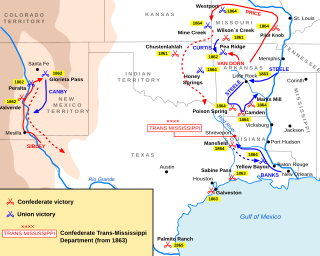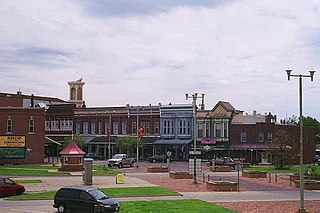
The Kansas–Nebraska Act of 1854 was an organic act passed by the 33rd U.S. Congress that created the territories of Kansas and Nebraska and was drafted by Democratic Senator Stephen A. Douglas of Illinois and President Franklin Pierce. The initial purpose of the Kansas–Nebraska Act was to open up thousands of new farms and make feasible a Midwestern Transcontinental Railroad. In addition to creating the U.S. territories of Kansas and Nebraska, the Kansas-Nebraska Act also allowed each territory to decide, "under the concept of popular sovereignty, whether they wanted slavery or not." The Kansas-Nebraska Act effectively repealed the Missouri Compromise, which had prohibited slavery in all U.S. territories west of the Mississippi River and north of 36°30' latitude. The popular sovereignty clause of the law led pro- and anti-slavery elements to flood into Kansas with the goal of voting slavery up or down, resulting in a series of armed conflicts known as "Bleeding Kansas". Controversy surrounding the Kansas-Nebraska Act was a cause of the Civil War.

The Battle of Prairie Grove was a battle of the American Civil War fought on December 7, 1862, that resulted in a tactical stalemate but essentially secured northwest Arkansas for the Union.
The Army of the Frontier was a Union army that served in the Trans-Mississippi Theater during the Civil War. It fought in several minor engagements in Arkansas, Indian Territory, and Kansas. In June 1863 the Army was discontinued but many of its regiments were formed into the District of the Frontier.
The Second Battle of Independence was a minor engagement of the American Civil War October 21–22, 1864 centered in Independence, Missouri, with some of the fiercest fighting taking place at the present-day United Nations Peace Plaza; the "Harry Truman" Railroad Depot; George Caleb Bingham's residence in the city, the Community of Christ church's Temple, Auditorium and "Stone Church"; and the headquarters of the Church of Christ. The Second Battle of Independence was actually two separate battles, the first day resulting in Price's army driving Blunt's army west, out of Independence, and the second day resulting in Pleasonton's cavalry driving Price's army west, out of Independence.
The Battle of Little Blue River was a minor battle of the American Civil War, occurring on October 21, 1864 in Jackson County, Missouri during Price's Missouri Expedition of that year. It became the opening round of the Second Battle of Independence, which began on this same day and was essentially a continuation of this engagement. This led in turn to the Battle of Westport on October 23, resulting in Price's defeat and the ending of major Confederate military operations in Missouri.

The Second Battle of Newtonia was fought on October 28, 1864, in Newton County, Missouri, as part of Major General Sterling Price's Missouri Expedition of the American Civil War.

Price's Missouri Expedition, also known as Price's Raid, was a Confederate raid through the states of Missouri and Kansas in the Trans-Mississippi Theater of the American Civil War during the autumn of 1864. Led by Confederate Major General Sterling Price, the campaign's intention was to recapture Missouri and renew the Confederate initiative in the larger conflict.

The Battle of Honey Springs on July 17, 1863, was an American Civil War engagement and an important victory for Union forces in their efforts to gain control of the Indian Territory. It was the largest confrontation between Union and Confederate forces in the area that would eventually become Oklahoma. The engagement was also unique in the fact that white soldiers were the minority in both fighting forces. Native Americans made up a significant portion of each of the opposing armies and the Union force contained African-American units.

The Trans-Mississippi Theater of the American Civil War consists of the major military operations west of the Mississippi River. The area is often thought of as excluding the states and territories bordering the Pacific Ocean, which formed the Pacific Coast Theater of the American Civil War (1861-1865).
The Battle of Old Fort Wayne was an American Civil War battle on October 22, 1862 in Delaware County in what is now eastern Oklahoma, a part of the Trans-Mississippi Theater.

During the American Civil War, most of what is now the U.S. state of Oklahoma was designated as the Indian Territory. It served as an unorganized region that had been set aside specifically for Native American tribes and was occupied mostly by tribes which had been removed from their ancestral lands in the Southeastern United States following the Indian Removal Act of 1830. As part of the Trans-Mississippi Theater, the Indian Territory was the scene of numerous skirmishes and seven officially recognized battles involving both Native American units allied with the Confederate States of America and Native Americans loyal to the United States government, as well as other Union and Confederate troops.
Fort Baxter, also known as Fort Blair, was a small US Army post located in the southeast corner of Kansas near present-day Baxter Springs. This area was known as the Cherokee Strip. It was one of a few Kansas forts attacked by Confederate forces during the American Civil War. At one point the Confederate government claimed authority over the Neutral Lands. Both Union and Confederate troops operated in the area, as did guerrilla forces and militias prevalent in the Kansas-Missouri border area.
William Weer was a lawyer, attorney general for Kansas and an officer in the Union Army during the American Civil War. He is notable for his service in the Trans-Mississippi Theater early in the war and later for being dismissed from the army following a court-martial.
In early May 1863 a temporary camp, Camp Hooker, was established at the site of what later became Baxter Springs, Kansas. This area was located in what was known as the Cherokee Strip (Kansas). In late May while the camp commander, Col. James M. Williams, was in Fort Scott, the troops moved the camp three blocks to the east to what is now Washington School Hill. The new camp, Camp Ben Butler (named after Maj. Gen. Benjamin Butler, was in a highly defendable position. It occupied a plateau that covered more than two square blocks. Only a small area to the south allowed easy access to camp. In fact, much of the surrounding area was practically impenetrable by men or horses.
During the Civil War, Coldwater Grove existed 13½ miles east of Paola, Kansas. It straddled the Kansas-Missouri border, being partly in both states. About June 1863 a Union military post was established on the Kansas side of the community and the post was put under the command of Lt. Col. Charles S. Clark. Clark also commanded four nearby posts.
The Confederate States Bureau of Indian Affairs was a subdivision of the Confederate States War Department established in 1861 to handle the duties the War Department was charged with regarding the Confederacy's relations with the various Indian Nations with which it interacted.
The Department of the Northwest was an Army Department created September 6, 1862 by the Union Army to put down the Sioux uprising in Minnesota. It was composed of the forces within the territory of the states of Wisconsin, Minnesota and Iowa, and the Nebraska and Dakota Territories . Nebraska Territory was detached to the Department of the Missouri on Oct. 11 1862.
LeRoy's post was established September 12, 1861, by U.S. Senator James H. Lane, when Fort Scott was threatened by advancing Confederate troops. LeRoy is a town in eastern Kansas. The post was one of many Union posts established in eastern Kansas to guard against Confederate guerrilla attack. In spring 1862 a number of Indian refugees who had first camped at Fort Row were moved further north to Fort Belmont and the post at LeRoy.
Osage Mission's post was located at the Osage Catholic Mission, which was established in 1847. Eventually, Osage Mission became the town of St. Paul, Kansas, inside what would become Neosho County, Kansas. The Mission was located about 35 miles (56 km) north of the Kansas-Indian Territory border. Indian Territory eventually became the state of Oklahoma. When the Civil War erupted, Father John Schoenmakers wanted to keep the Mission as neutral ground and thus out of the conflict. Although at one point Schoenmakers had to flee for a time, he pretty much succeeded in keeping Osage Mission itself out of harm's way.









